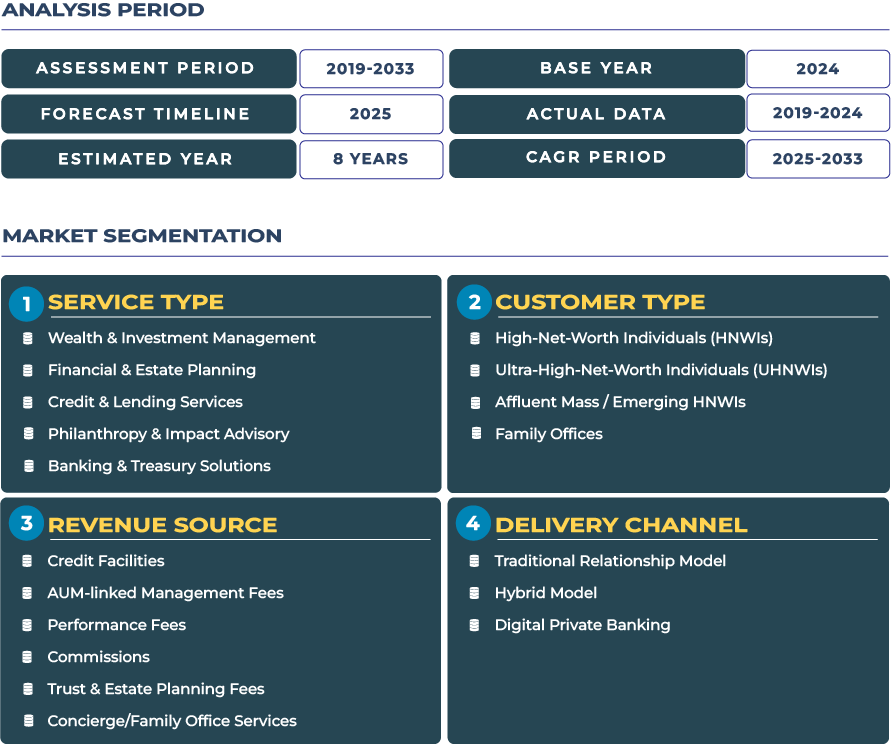Vision 2030 Wealth Transformation: Redefining the Saudi Arabia Private Banking Market
Saudi Arabia private banking industry is entering a transformative decade as Vision 2030 accelerates economic diversification, wealth creation, and private capital mobilization. The market, valued at USD 9.7 billion in 2025, is projected to reach USD 18.4 billion by 2033, expanding at a robust CAGR of 8.3% during 2025–2033. This growth reflects the country’s shift from oil-centric revenues to diversified investment channels encompassing real estate, technology, healthcare, and sustainable energy sectors. The structural reforms driven by the Public Investment Fund (PIF) and the Saudi Central Bank (SAMA) are fostering a conducive environment for wealth management innovation and family-office consolidation.
The evolution of private banking in the Kingdom is deeply tied to institutional modernization and the emergence of ultra-high-net-worth individuals (UHNWIs). Domestic wealth creation, propelled by privatization programs, IPOs, and cross-border investments, is reshaping the competitive dynamics. Additionally, Saudi Arabia’s growing appetite for Sharia-compliant wealth management, philanthropic advisory, and green finance products is steering private banks to enhance digital capabilities and regulatory compliance to meet evolving client expectations.
Note:* The market size refers to the total revenue generated by banks through various services.
Drivers & Restraints: Balancing Economic Reform Momentum with Regulatory Modernization
Accelerating Wealth Diversification under Vision 2030
The driving force behind Saudi Arabia’s private banking market expansion lies in Vision 2030’s commitment to economic diversification. The Kingdom’s sovereign wealth strategy, led by PIF’s ambitious portfolio exceeding USD 700 billion, channels national capital into renewable energy, tourism, and technology ventures. This, in turn, stimulates domestic wealth accumulation and institutional investment. Family-owned conglomerates are professionalizing financial structures, boosting demand for private banking services such as succession planning, estate structuring, and offshore diversification. The government’s reforms to enhance transparency and international partnerships are positioning Riyadh as a regional financial hub for wealth management excellence.
Rising Ultra-High-Net-Worth and Family Office Growth
Saudi Arabia’s rising number of HNWIs and UHNWIs continues to be a significant catalyst for private banking expansion. The entrepreneurial ecosystem fostered by the Ministry of Investment has increased the number of successful start-ups and new wealth contributors. Family offices are evolving from traditional custodians of capital into professionalized, multi-generational wealth entities that demand advanced investment advisory, credit, and ESG-focused services. This shift is driving private banks to strengthen personalized portfolio management and digital wealth monitoring systems tailored to family governance models.
Challenges: Navigating Regulatory Adaptation and Talent Shortage
Despite its strong trajectory, the Saudi private banking sector faces several headwinds. Regulatory adaptation and the pace of compliance modernization continue to challenge smaller institutions. The limited pool of wealth management professionals with global expertise restricts innovation capacity. Gender participation gaps in financial leadership also create structural imbalances in client engagement. Furthermore, while digital transformation is underway, some private banks still lag in full-scale digital advisory integration, constraining competitiveness in a rapidly evolving marketplace. Inflationary pressures and geopolitical uncertainties in the Middle East could also create short-term volatility for wealth flows and private capital deployment.
Trends & Opportunities: ESG Integration and Digitalization Reshape Saudi Wealth Paradigms
ESG Sukuk and Sustainable Wealth Management
One of the most prominent trends in Saudi Arabia’s private banking landscape is the rise of ESG-aligned sukuk and sustainable portfolios. The growing alignment of private wealth with national sustainability goals reflects a broader regional shift toward green finance. Leading institutions are incorporating ESG-screened equities, renewable energy funds, and impact-oriented investments within Sharia-compliant frameworks. This convergence of ethics, innovation, and profitability positions the Saudi market at the forefront of responsible wealth management in the Gulf region.
Family Office Institutionalization and Governance Formalization
Family offices in Saudi Arabia are undergoing rapid institutionalization, creating opportunities for private banks to offer customized governance and advisory services. With generational transitions intensifying, succession planning, estate governance, and philanthropic advisory are becoming strategic differentiators. Private banks are introducing structured lending and liquidity management tools to align with family-owned corporate transitions. The integration of tax-efficient cross-border structures further enhances Saudi Arabia’s appeal as a private banking hub for regional wealth.
Digital Private Banking and Wealth Accessibility
Digital transformation has become a defining opportunity for the Saudi private banking sector. From online onboarding and mobile wealth management platforms to AI-driven investment analytics, institutions are optimizing user experience and operational scalability. Riyadh-based banks are investing in digital advisory ecosystems that offer real-time portfolio insights and goal-based planning tools. This trend is expanding access to wealth management services beyond UHNWIs, catering to emerging affluent clients seeking professional investment strategies. The integration of fintech partnerships, supported by SAMA Fintech Saudi initiative, is driving a new era of inclusive financial sophistication.
Competitive Landscape: Strategic Reinvention among Local and Global Wealth Managers
The Saudi Arabia private banking landscape is dominated by established domestic players and international financial institutions expanding their regional footprint. Local leaders such as NCB Capital and Riyad Bank are focusing on Sharia-compliant wealth products and ESG-based investment portfolios to capture rising domestic demand. Meanwhile, global banks with a long-standing presence in the Kingdom, such as HSBC and BNP Paribas, are scaling digital and advisory solutions tailored to Vision 2030 investors.
Key strategies shaping the competitive environment include the development of hybrid wealth platforms that integrate onshore and offshore advisory. Saudi banks are strengthening collaborations with sovereign funds and investment entities to co-create ESG and impact-focused wealth strategies. The move toward professionalizing the family-office ecosystem-through structured governance frameworks and international compliance standards-underscores Saudi Arabia’s determination to align its private banking sector with global best practices. Partnerships between private banks and government-backed entities, particularly under Vision 2030 initiatives, are further catalyzing innovation in sustainable finance and digital private banking.







